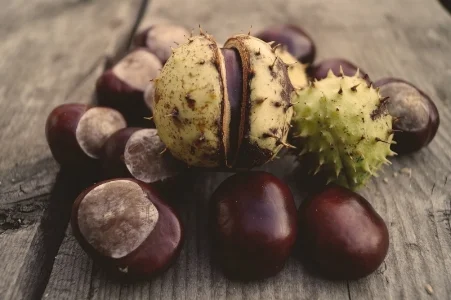12 October 1942 – Kings and Queens / Re e Regine
Playing in the schoolyard
My father always had a love for chestnut trees, especially the horse-chestnut variety, called in Latin, Aesculus hippocastanum. When I lived in Bethlehem, Pennsylvania, there was a horse-chestnut tree in front of my apartment building, the former Lehigh Railroad Office. I remember him scooping up a bunch of brown chestnuts, handing me one, and popping the rest in his pockets.
When I read this diary entry, I realized why my dad loved them so.
Rovigno, 12 ottobre 1942
“Nel pomeriggio di oggi mi sono divertito a fare re, regine, cortigiani e guerrieri con castagne, chiodi, stagnola, e carte multicolori. Graziosa mi è riuscita la regina Taitù. Aveva un bel musetto dipinto in rosso e un diadema in fronte che era un fondo di bicchiere. Il mantello a strascico era sorretto da due negretti.”
Rovigno, 12 October 1942
“This afternoon I had fun playing king, queen, courtiers and warriors with chestnuts, nails, foil, and multicolored papers. I was pretty successful at Queen Taitù. She had a pretty face painted in red and a tiara on her forehead, made from the bottom of a glass. Two little slaves supported the train of her cape.”
Even today, there are horse-chestnut trees (Aesculus hippocastanum L. – Ippocastano) on the grounds of my father’s school. You can see the school today on their website, Scuola Media Superiore Italiana Rovigno, SMSIR. For a description of the school’s history (in Italian), as well as the plants and trees, click here. My father wrote me a wonderful poems about horse-chestnuts, which I will share in a later post.
For those who don’t know, as I did not, Queen Taitù (Taytu Betul), was Empress of Ethiopia in 1889 alongside her husband, Emperor Menelik. Together, they successfully fought against the Italians in the Battle of Adwa in 1896. She became known for her leadership and tough stance where her husband was sometimes less aggressive, as well as her judgement and loyalty. She had a very comprehensive education and was the founder of the city of Addis Ababa.
“Queen Taitù” was sometimes used by Italians to describe controlling women, women who were willing to contradict their men in public. («Crede di essere la regina Taitù») Nevertheless, she was a powerful and strong leader, who forged the path leading to the decolonization of Africa.
Now, please allow me another caveat. Yes, I realize my father wrote “negretti,” which has several translations. “Negro” is una parola storica—an outdated term for slaves, Africans, or here in the United States, African-Americans. I realize this term may be offensive to some, however I’ve chosen to leave the word as my father wrote it (he was ten, remember), and elected to use the word slaves in a general sense instead.
However, something else is lurking, waiting to strike.
“Il re aveva un manto rosso sotto di cui si intravedevano le brache. Seguiranno i cortigiani con mantelli verdi. Un cortigiano reggeva un parasole, che era una (mantello) campanella azzurra. Seguiranno il reale corteggio, i guerrieri: gallo, sudanesi, etiopici, armati di lance, scudi, frecce, e tamburi. Avevano le pance tatuate in modo svariato.
Li schierai in ordine di battaglia e, sul più bello, saltò sul tavolo il gatto di signora Catina che fece una strage degna di un rodomonte. Allora io, arrabbiato, presi il mio pugnale vero e feci un massacro generale dei guerrieri rimasti.”
“The king had a red cloak beneath which could be seen his trousers. Followed by the courtiers with green cloaks. A courtier was holding a parasol, which was a (cloak) blue bell (Morning Glory flower). Following the royal retinue, the warriors: Gaul, Sudanese, Ethiopians, armed with spears, shields, arrows, and drums. They had their bellies tattooed in various ways.
I deployed them in battle order and, at that moment, onto the table jumped Mrs. Catina’s cat who made a killing worthy of a swashbuckler. Then I, enraged, took my real knife and made a wholesale massacre of the remaining warriors.”
Horse-chestnut people / La gente delle ippocastagne
Poor Franco, defeated by a cat!







